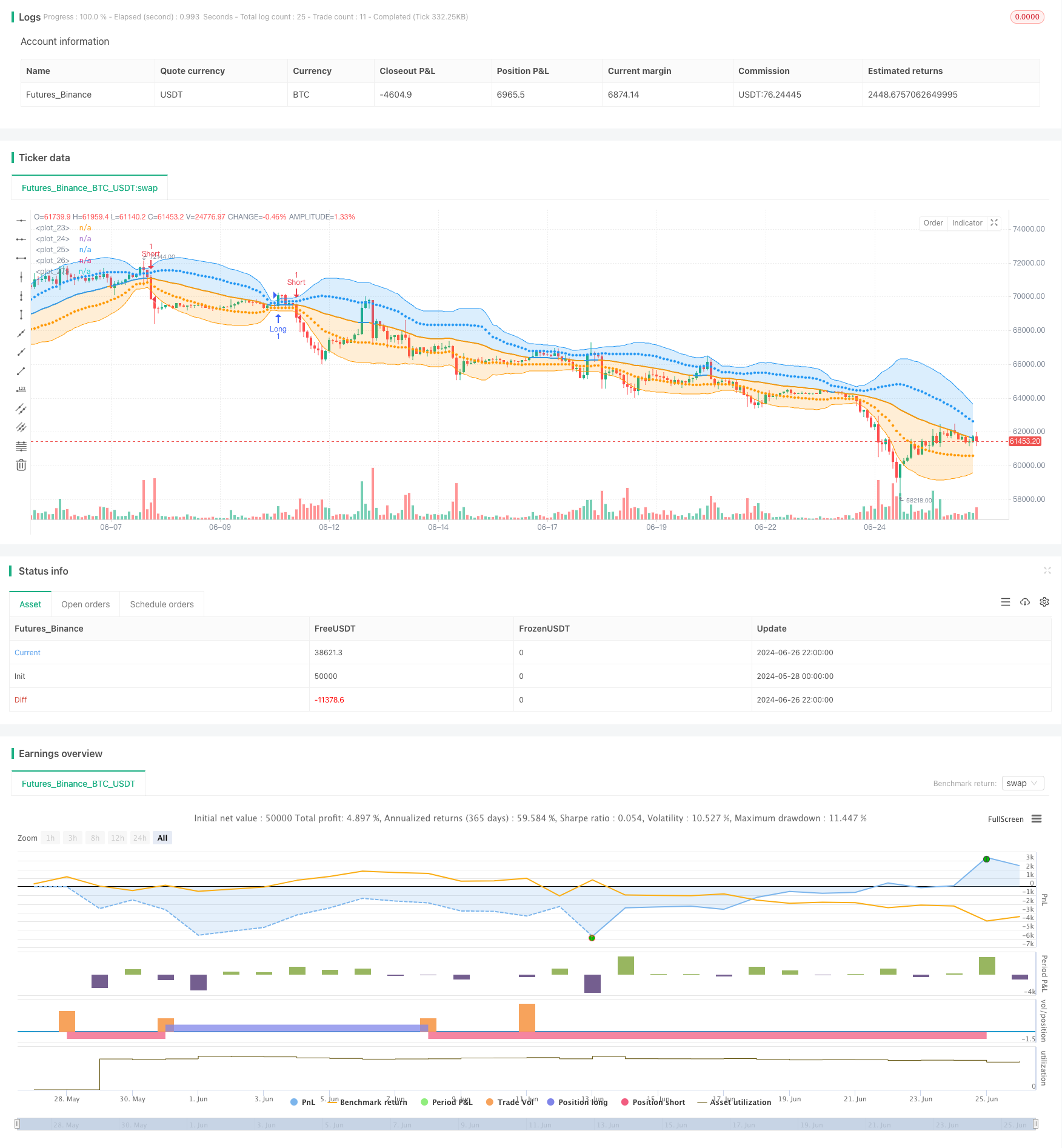
概述
本策略是一个基于布林带指标的增强型交易系统,通过使用双重标准差带来优化传统布林带策略。该策略利用价格与不同标准差水平的交互来生成交易信号,旨在捕捉市场的趋势和反转机会。
策略原理
该策略的核心是使用两个不同级别的布林带:
- 基于34周期简单移动平均线(SMA)计算布林带。
- 内层布林带使用1个标准差,外层布林带使用2个标准差。
- 当价格突破外层布林带上轨时,触发做多信号;突破下轨时,触发做空信号。
- 当价格回落至外层布林带下轨时,平掉多头仓位;回升至上轨时,平掉空头仓位。
这种双层布林带设计允许策略在不同的市场条件下灵活运作,既能捕捉强劲趋势,又能识别潜在的反转点。
策略优势
- 动态适应性:布林带会根据市场波动性自动调整,使策略能够适应不同的市场环境。
- 趋势跟踪与反转:该策略既能跟随强劲趋势,又能在极端情况下寻找反转机会。
- 风险管理:使用外层布林带作为止损点,有助于控制每笔交易的风险。
- 视觉反馈:策略提供清晰的视觉反馈,帮助交易者直观理解市场状况。
- 灵活性:参数可调整,允许交易者根据不同的市场和个人偏好进行优化。
策略风险
- 假突破:在横盘市场中,价格可能频繁触及布林带边界,导致过多的假信号。
- 滞后性:作为滞后指标,布林带可能在快速变化的市场中反应不及时。
- 过度交易:在高波动性市场中,可能产生过多的交易信号,增加交易成本。
- 趋势依赖:在无明显趋势的市场中,策略表现可能不佳。
- 参数敏感性:策略性能高度依赖于所选择的参数,不同市场可能需要不同的优化设置。
策略优化方向
- 引入额外过滤器:结合其他技术指标(如RSI或MACD)来确认信号,减少假突破。
- 动态参数调整:根据市场波动性自动调整布林带参数,提高策略适应性。
- 加入成交量分析:将成交量作为辅助指标,提高信号的可靠性。
- 实现自适应周期:使用自适应周期而非固定周期,以更好地捕捉市场节奏。
- 优化仓位管理:根据布林带宽度动态调整仓位大小,在高确定性时增加仓位。
- 加入市场状态识别:在策略中加入市场状态(趋势/震荡)的判断,以适应不同市场条件。
总结
增强型动态布林带交易策略是一个灵活而强大的交易系统,通过使用双层布林带结构,有效地平衡了趋势跟踪和反转交易的需求。该策略的主要优势在于其动态适应性和清晰的视觉反馈,使其成为适合各种市场条件的有力工具。然而,交易者需要注意假突破和过度交易的风险,并考虑引入额外的过滤器和动态参数调整来优化策略性能。通过持续的测试和优化,这个策略有潜力成为一个可靠的交易系统,为交易者提供稳定的盈利机会。
策略源码
/*backtest
start: 2024-05-28 00:00:00
end: 2024-06-27 00:00:00
period: 2h
basePeriod: 15m
exchanges: [{"eid":"Futures_Binance","currency":"BTC_USDT"}]
*/
//@version=5
// Bollinger Bands: Madrid : 14/SEP/2014 11:07 : 2.0
// This displays the traditional Bollinger Bands, the difference is
// that the 1st and 2nd StdDev are outlined with two colors and two
// different levels, one for each Standard Deviation
strategy(shorttitle='MBB', title='Bollinger Bands', overlay=true)
src = input(close)
length = input.int(34, minval=1)
mult = input.float(2.0, minval=0.001, maxval=50)
basis = ta.sma(src, length)
dev = ta.stdev(src, length)
dev2 = mult * dev
upper1 = basis + dev
lower1 = basis - dev
upper2 = basis + dev2
lower2 = basis - dev2
colorBasis = src >= basis ? color.blue : color.orange
pBasis = plot(basis, linewidth=2, color=colorBasis)
pUpper1 = plot(upper1, color=color.new(color.blue, 0), style=plot.style_circles)
pUpper2 = plot(upper2, color=color.new(color.blue, 0))
pLower1 = plot(lower1, color=color.new(color.orange, 0), style=plot.style_circles)
pLower2 = plot(lower2, color=color.new(color.orange, 0))
fill(pBasis, pUpper2, color=color.new(color.blue, 80))
fill(pUpper1, pUpper2, color=color.new(color.blue, 80))
fill(pBasis, pLower2, color=color.new(color.orange, 80))
fill(pLower1, pLower2, color=color.new(color.orange, 80))
if (close > upper2)
strategy.entry("Long", strategy.long)
if (close < lower2)
strategy.entry("Short", strategy.short)
if (close <= lower2)
strategy.close("Long")
if (close >= upper2)
strategy.close("Short")
相关推荐